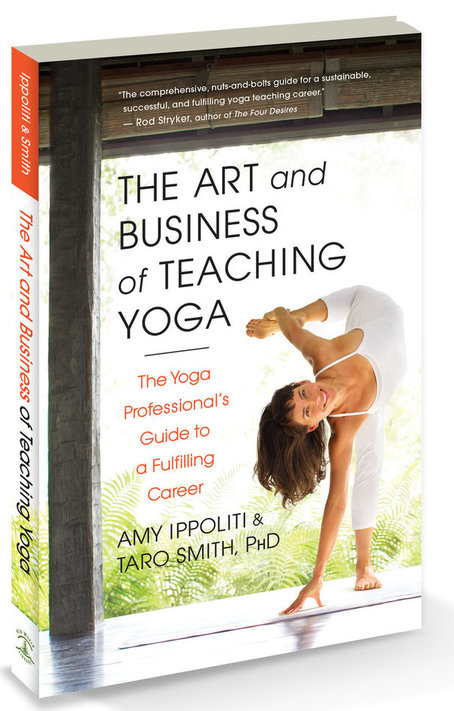
In their new book The Art and Business of Teaching Yoga: The Yoga Professional’s Guide to a Fulfilling Career, yoga “teacher of teachers” Amy Ippoliti and wellness entrepreneur Taro Smith, PhD, build on their popular “90 Minutes to Change the World” online course for yoga professionals to offer instructors a road map for creating a career that sustains and inspires not only themselves but their students as well.
*Editor’s Note: Here at elephant, we’re notorious bookworms—we love them, and want you to love them, too. But, recently, we found out books are evil—one of the worst things for the environment. Before you buy your next book, read this and this. Keep reading, but read responsibly.
Yoga Journal and Yoga Alliance, the professional organization representing yoga teachers, studios, and schools, conducted an extensive study into the current state of yoga in the United States.
According to their 2016 “Yoga in America” report, 36.7 million people practice yoga, up from 20.4 million in 2012. Yoga is not only growing, it’s booming. In fact, 28 percent of all Americans have taken a yoga class at some point in their lives. More men and more older people are practicing than ever before: in 2015, there were approximately 10 million male practitioners and almost 14 million practitioners over the age of 50.
Yogis are also contributing to the economy, spending over $16 billion annually on classes, yoga clothing, equipment, and accessories, up from $10 billion in 2012. Evidently, yoga is enticing: 34 percent of Americans say they are somewhat likely or very likely to practice yoga in the next twelve months—which is equal to more than 80 million Americans. Why do they want to try yoga? They reported wanting to increase their flexibility, relieve stress, and improve their fitness levels.
According to the survey, yoga is an increasing part of life in the United States. Since 2012, the percentage of Americans aware of yoga has jumped from 75 percent to 90 percent. One in three Americans have tried yoga on their own (not in a class) at least once.
The findings also indicate that yoga practitioners tend to have a positive self-image: they are 20 percent more likely than nonpractitioners to report that they have “good balance,” “good physical agility or dexterity,” or “good range of motion or flexibility” or that they “give back to the community.”
The study also shows that yoga students are highly concerned about their health, their community, and the environment. More than 50 percent of practitioners report trying to eat sustainable foods and live green, compared with about a third of the general population. Nearly half of yoga practitioners report donating time to their communities, compared with just 26 percent of those who don’t practice yoga.
Perhaps not surprisingly, yoga teachers and teacher trainees are even more tuned in to environmental and social issues and to living and eating consciously than other yoga practitioners: 22 percent of yoga teachers and trainees are vegetarians, compared with 8 percent of other yoga practitioners and 3 percent of the general public; and 60 percent of yoga teachers and trainees use natural health and beauty products, compared with 44 percent of other yoga practitioners and 21 percent of the general public.
Statistics like these support what has always been true in the yoga circles in which I run: yogis are living life with more self-awareness and positive self-regard, and as a result of this increased sensitivity, they are making an encouraging difference for the environment and in their communities.
What does all this mean for you as a teacher or aspiring teacher? The demand for yoga teachers is higher than ever—and unlikely to decrease anytime soon.
The Challenges of Being a Yoga Teacher
With statistics like those above, it’s clear that as a yoga teacher, you’re part of a movement that is growing exponentially and one that is becoming more and more a part of life in our society. As exciting as this can be, it’s important to recognize that there are also challenges that come along with becoming or being a teacher. This book will help you understand and minimize these challenges, see how they apply to your specific situation, and find ways to manage them with skill and finesse.
First, with the growing popularity of yoga, the demand for teacher training has created a small army of yoga teachers all over the world, and you are just one of them. It’s not as easy to stand out as it used to be.
At the same time, because of this popularity, modern yoga is sometimes criticized as being overly commercialized. Awareness of these criticisms can make it difficult to feel confident promoting yourself, spreading the word about your teaching, or asking to be compensated for your time and energy.
What’s more, even though you have probably invested lots of time and money in developing your yoga education, teaching yoga has not traditionally been a lucrative career.
Yoga and Money
The ethical aspects of combining yoga with business, money, and marketing can be troubling: 50 percent of yoga teachers polled in our courses reported feeling awkward about charging for their teaching. But a great many of these teachers reported that they felt uncomfortable because of what other people think about yoga and money.
The reality is that yoga means different things to different people. Here are three common categories or belief systems:
1. Those who think that yoga should maintain its roots solely in an esoteric and spiritual practice and are therefore more likely to have a hard time with the commercial side of yoga and its marketing and promotion.
2. Those who see yoga teaching as a hobby or side job. These yogis are usually fortunate enough to be able to teach without worrying about compensation.
3. Those who live fully in the 21st century, modern world and see teaching yoga as a profession through which they earn a living.
If you’re serious about teaching yoga as an occupation, I’d like to help you understand why the third category is the clear choice and how the other two belief systems can confuse the profession of teaching yoga.
Yoga is now a $16 billion industry in the United States. Marketing of yoga accessories—everything from mats, props, and bags to yoga-specific clothing and even jewelry and nutritional supplements—has exploded. Promoters organize yoga conferences and festivals with lots of tangentially related activities, such as music concerts, slacklining, hula hooping, stand-up paddle boarding, and even wine tasting. With the promotional efforts that accompany these enterprises, criticism is inevitable.
For yoga teachers thinking of yoga as both a practice and a profession, it’s helpful to understand the current state of affairs, and also to know a little of the history of yoga in both India and the West. Yoga practice and teaching in the West have been heavily influenced by particular schools of yoga with a focus on spiritual enlightenment—the traditions of Patanjali’s classical yoga and Advaita Vedanta—using yoga to transcend our identification with the material world. Practitioners of these forms of yoga renounced material wealth and other forms of indulgence, many taking vows of celibacy. But these schools of yoga and their philosophies are not the only ones; they just happen to be the forms that gained an early foothold in the West. As a result, the yoga world is dealing with the residual effects of this one outlook.
Those who object to treating yoga as a business perhaps fail to consider that yoga is not solely a spiritual practice: it is a form of education, encompassing physical activity, wellness, philosophy, and even history. And if yoga is a multifaceted form of education rather than an esoteric spiritual quest, it stands to reason that, as with other forms of training, such as piano lessons or a language course, a yoga education costs money. It is time for a more modern paradigm in the West, one that regards teaching yoga, like other forms of schooling, as a legitimate profession.
While sleazy marketing is unattractive in any field, and particularly in yoga, yoga cannot be kept free of promotion or commerce. If yoga teachers do not promote the merits of yoga and their own expertise in teaching it, then how will people find the path to those benefits? The great rewards of yoga are worth sharing with the world. The distinctive gifts that yoga teachers can offer their students are worth publicizing, and in our modern world they have monetary value.
It might help to apply some fundamental yoga philosophy to the controversy. The Yoga Sutras of Patanjali (second century ce) discusses two concepts for explaining reality: prakriti and purusha.
Prakriti encompasses matter, the material world, feelings and emotions, anything that changes, diversity, and the “little things,” including money. Purusha encompasses spirit, the absolute, the eternal, that which does not change.
Purusha-prioritizing traditions see the material world as a problem to be fixed or to withdraw from. Sayings such as “I am not this body, I am not this mind” and “All of that is an illusion” come from a school identified with purusha. Strict followers attempt to suppress their feelings, stanch desire, conquer the human ego, and retreat from the real world through meditation in order to attain the beautiful vision of purusha. An exclusive focus on other-than-the-world makes it difficult to negotiate our twenty-first-century sphere.
There is an alternative view that embraces both prakriti and purusha. It is embodied in the Tantric schools of yoga, which are not as well known in the West. Tantra has come to be thought of as all about sexuality, but it is actually a much broader body of yoga and philosophy, one that addresses all aspects of human life. (To learn more about the origins of Tantra, we recommend The Origins of Yoga and Tantra by Geoffrey Samuel or The Alchemical Body by David G. White.)
Embracing both prakriti and purusha allows us to acknowledge that there are mouths to feed, worthy organizations working to make a difference that need our support, bills to pay, and kids to put through college. None of this is illusory; it is real.
Dichotomies that characterize yoga as beautiful and consumerism as ugly are neither helpful nor realistic. In fact, there is no escaping consumerism through yoga; humans, like everything else in the food chain, must eat and consume resources. The more interesting and important question is, How can we create a paradigm for thinking about money and consumerism that is ethical, conscious, and sustainable?
Excerpted from the book The Art and Business of Teaching Yoga: The Yoga Professional’s Guide to a Fulfilling Career. Copyright © 2016 by Amy Ippoliti and Taro Smith, PhD. Reprinted with permission from New World Library.
More from Amy Ippoliti about what yoga teachers need to know:
Authors: Amy Ippoliti & Taro Smith
Images: Courtesy of Author, INDISKA/Flickr
Editors: Catherine Monkman; Travis May











Read 0 comments and reply